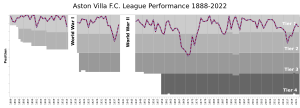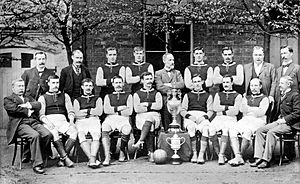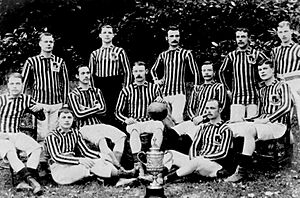History of Aston Villa F.C. (1874–1961) facts for kids

Aston Villa Football Club started in 1874. Fifteen members of the Wesleyan Chapel at Villa Cross formed the club. Four key founders were Jack Hughes, Frederick Matthews, Walter Price, and William Scattergood. The club won its first FA Cup in 1887. Aston Villa was one of the twelve teams that started the first Football League in 1888. The club's chairman, William McGregor, was the league's founder. Aston Villa became the most successful English club during the Victorian era. By the time the First World War began, Villa had won the League Championship six times. They had also won the FA Cup five times.
Aston Villa won their sixth FA Cup in 1920. After this, the club slowly declined. They were relegated to the Second Division in 1936. This was the first time in their history. They returned to the top league before the Second World War. The war brought many changes to Villa Park. The 1940s were spent rebuilding the team. By 1957, Villa won the FA Cup again, their seventh victory. Villa won the first ever League Cup in 1960. However, the club then entered a very difficult period. The 1960s saw many changes at Villa Park. By the end of the 1960s, Villa was struggling in the Second Division. Fans pushed for changes, and Doug Ellis became the new Villa Chairman.
Contents
How Aston Villa Started
From Cricketers to Footballers
Co-founder Jack Hughes said that Aston Villa Football Club began with fifteen players. Most of them were from the Aston Villa Wesleyan Chapel cricket team. These players wanted something to do during the winter months. The club's official history says they chose football after watching a game. It was an "impromptu game on a meadow off Heathfield Road." Jack Hughes, Frederick Matthews, Walter Price, and William Scattergood were the four founders. They were chosen to watch the game.
In 1876, Villa moved to their first official home, Wellington Road. Their new captain, George Ramsay, suggested the move. He believed Villa needed an enclosed ground to collect money from fans. The club rented the site for three years. The rent started at £7.10 shillings for the first year. It then increased to £15 and £20 in later years. By the late 1870s, Villa was getting much better. In 1880, Villa won their first big trophy. They won the Birmingham Senior Cup with Ramsay as captain.
Becoming a Top Team
First FA Cup Win and League Creation
The club won its first FA Cup in 1887. Archie Hunter, another Scotsman, was the captain. They beat West Bromwich Albion 2–0 in the final. The game was played at The Oval. Before 1885, football was an amateur sport. It became professional in 1885. The FA allowed professional players but set a national wage limit.
William McGregor, a Scottish director at Aston Villa, was unhappy. He saw his team playing easy friendly matches. Also, not many people came to games, except for FA Cup ties. McGregor believed that top teams needed to play each other regularly. This would keep interest in the game high. He thought of a league, similar to American baseball teams. McGregor wrote to the twelve leading clubs in England. He suggested forming a league, which became the English Football League. Aston Villa was one of the twelve teams in the first Football League in 1888. Villa's first League game was on September 8, 1888. They drew 1–1 with Wolverhampton Wanderers. Tom Green scored the club's first League goal. Villa finished second to Preston North End in that first season.
The Golden Era: Victorian and Edwardian Times
Winning Titles and Moving Home
Even though Villa helped start the league, they hadn't won it by 1893. Frederick Rinder, a Villa Committee Member, led a meeting in February 1893. This meeting removed the committee that was running the club. All fourteen committee members resigned. A new committee of five, led by Rinder, took over. He had criticized the old board for allowing bad discipline and players drinking.
The next season, Villa won their first League Championship. The season after that, they won their second FA Cup in 1894-95. This was followed by winning the League title two years in a row, in 1895-96 and 1896-97.

Villa was attracting huge crowds. About 25,000 people regularly came to home games. At that time, the FA Cup Final only attracted about 20,000. The Wellington Road ground was becoming unsuitable. It had poor facilities and an uneven pitch. In 1897, the year the club won the League and FA Cup Double, Villa's financial secretary Rinder bought their current home ground, the Aston Lower Grounds.
Villa won back-to-back league titles again in 1898-99 and 1899-1900. In the latter season, Billy Garraty became the top goalscorer in world football. He scored 30 goals in 39 league and cup games. The name Villa Park was not used until about 1900. Fans started using the name, and it became official without a formal announcement. The ground was not fully bought until 1911.
Continuing Success in the New Century

Villa started the 20th century as champions. However, the gap between them and other teams was shrinking. Football in England was becoming more competitive as more teams formed. Still, Villa remained a strong force. Despite winning four games at the start of the 1900–01 season, Villa finished fourth from bottom. In the 1902–03 season, Villa won 12 of their last 15 games. They finished only one point behind champions Sheffield Wednesday.
In 1905, Villa won the FA Cup for the fourth time. A record crowd of 101,117 watched the match at Crystal Palace. Villa beat Newcastle United 2–0. In the same season, Villa finished fourth in the league. This helped the club's finances. After the success of 1905, Villa had a quiet period. It wasn't until the 1909–10 season that Villa looked like winning the title again. In that season, they beat the reigning champions Manchester United 7–1. Villa won the championship for the first time in 10 years. This was their sixth title, a record at the time.
The 1910–11 season was very close. The title was decided on the last day. Villa lost to Liverpool, and Manchester United beat Sunderland to win the title. The next season, Villa finished sixth. But in 1913, Villa won the FA Cup for a record-equalling fifth time. By the end of what was called Villa's "golden era," when the First World War began, the club had won the League Championship six times and the FA Cup five times. This included winning both the League and Cup Double in 1896–97. This amazing achievement would not be repeated for over 60 years.
The Years Between the Wars
FA Cup Glory and Relegation
Football started again after the war for the 1919–20 season. Villa won their sixth FA Cup at the end of that season. They beat Huddersfield Town 1–0 at Stamford Bridge. In November 1923, Villa's centre-half Tommy Ball sadly passed away. He became the only active Football League player to have died in such circumstances.
In their Golden Jubilee season of 1923–24, Villa reached the second final held at the new Wembley Stadium. They lost 2–0 to Newcastle United. This Cup final was a high point. After this, Villa finished sixth and tenth in the following seasons. The club's directors tried to stop the decline by buying new players. In 1927, they bought both Jimmy Gibson and Eric Houghton.
In 1928, they signed one of the best goalscorers in English football. When Villa signed Tranmere Rovers striker Tom Waring for £4,700, he was not well known. Waring scored a record 49 league goals in the 1930–31 season. Villa finished second to Arsenal. Eric Houghton, another new player, scored 30 goals that season.
The team was playing well and scoring many goals. In the 1933–34 season, Villa had fourteen international players. They continued to challenge for trophies, finishing second in the League in 1933. However, this success did not last. A feeling of overconfidence at Villa Park led to a drop in form. This slump ended with their relegation from the top league in 1935–36. This was the first time in their history.
The relegation happened around the time they decided to appoint their first manager. Before the 1935–36 season, a committee chose the team. A "secretary" coached the team. The relegation was mainly due to a very poor defense. They let in 110 goals. Seven of those goals came from Arsenal's Ted Drake in a 1–7 defeat at Villa Park. Villa finished ninth in their first season in the Second Division. But they were crowned Second Division Champions in 1937–38. This was under the guidance of Jimmy Hogan. By the start of the Second World War, Aston Villa was back in the top league.
Aston Villa Reserves During WWII
The Aston Villa reserves (or second team) joined the army. They were captured during the Dunkirk evacuation in June 1940. In December, at a German camp, a German Guard regiment challenged British prisoners of war to a football game. The guards were losing 27–0 when they stopped the game. Only then did they learn that these prisoners were Aston Villa's second team.
Rebuilding After the War
New Players and FA Cup Success
For Villa, like all English clubs, the Second World War meant losing seven seasons. Several players' careers ended early because of the conflict. The first game at Villa Park after the war was against Middlesbrough. Villa lost 1–0 in front of 50,000 fans. Aston Villa began rebuilding the team. This was under the guidance of former player Alex Massie for the rest of the 1940s.
Massie made some bold signings. His first was 23-year-old Wales international Trevor Ford. He was bought from Swansea for £9,500 in 1946. Villa finished eighth in the League that year. Ford went on to score 60 goals in his four seasons at Villa Park. He was then sold in the 1950–51 season to Sunderland for £30,000. This was a British record at the time.
For the rest of the 1940s and early 1950s, Massie kept bringing in new players. The team regularly finished in the middle of the league table. One important signing was Danny Blanchflower in 1951 for £15,000. Villa had a good start to the 1951–52 season. After eight games, Villa was second, behind Manchester United. This was their best start in 19 years. They eventually finished in sixth place.
After a mid-table finish in the 1952–53 season, the next season saw the return of Eric Houghton. This time, he was the manager. One of his first actions was to bring 19-year-old Peter McParland into the first team. His first season in charge ended with Villa in 13th place. Still, "Houghton had done well to guide a changing Villa team to a respectable position in the top league." Under Houghton's leadership, Villa won the 1957 FA Cup Final. They played against Manchester United's famous Busby Babes. Peter McParland scored both goals in a 2–1 victory. This was Villa's record-equalling ninth FA Cup final. It was Aston Villa's first trophy in 37 years.
Ups and Downs
Relegation and League Cup Win
The success of the previous season turned out to be misleading. The team finished 14th, only seven points above relegation. Eric Houghton refused to resign. He was sacked when relegation seemed likely in 1958–59. His replacement, Joe Mercer, could not stop the club from being relegated in 1959. This was only the second time in its history. The fact that Villa reached the FA Cup semi-finals that year showed how complacent the club had become.
Villa only spent one season in the Second Division. They returned as Champions in 1960. The 1960–61 season was a successful one. Villa reached the semi-finals of the FA Cup. They finished ninth in the League. And they won the first ever League Cup. This was helped by a group of exciting young players. They became known as "Mercer's Minors."




